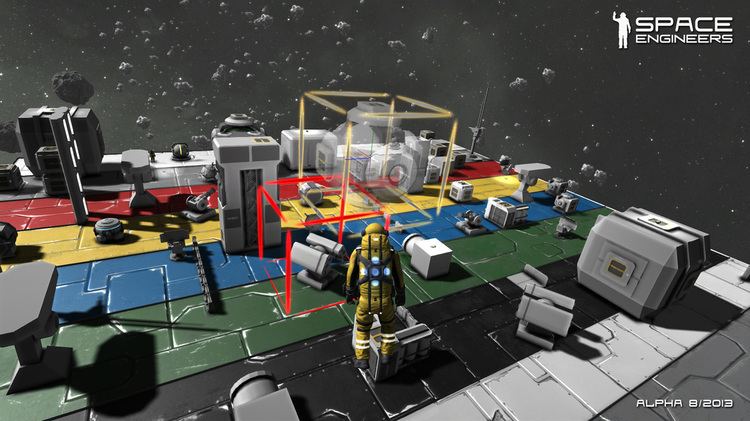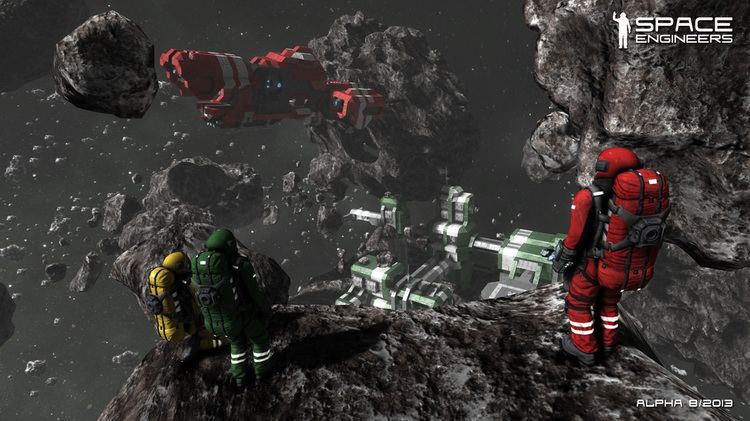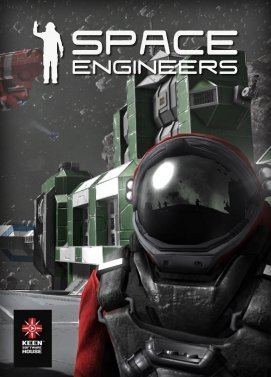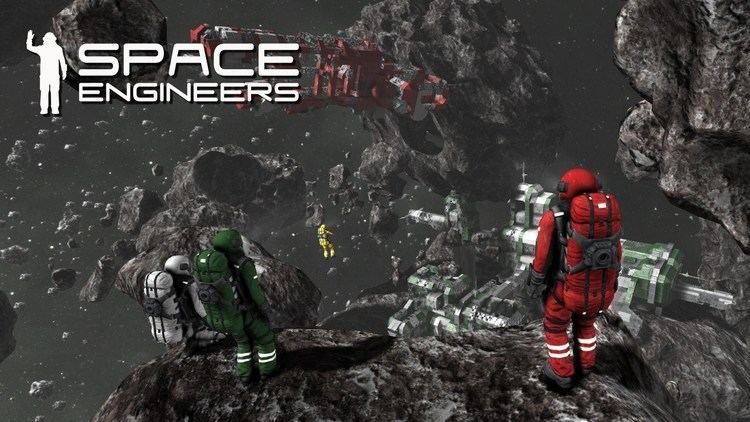9 /10 1 Votes9
Engine VRAGE 2.0 Initial release date 23 October 2013 Publisher Keen Software House | 9/10 Steam Developer Keen Software House | |||||||||||||||||||||||||||||||||
 | ||||||||||||||||||||||||||||||||||
Similar Dual Universe, Empyrion ‑ Galactic Survival, Kerbal Space Program, Star Citizen, StarMade | ||||||||||||||||||||||||||||||||||
Space engineers the mountain bunker
Space Engineers is a voxel-based sandbox game set in space and on planets. It is being developed and published by Czech Republic developer Keen Software House. Since 2013, it has been available on Steam as an early access game. While still in active development, Space Engineers has sold over one million units. In May 2015, the game's source code was made available to the community for easier modding. On December 15, 2016, the game officially entered Beta.
Contents
- Space engineers the mountain bunker
- Space engineers now with planets
- Gameplay
- Creative mode
- Survival mode
- Materials and items
- Inventories and Storage
- Planets
- Development
- Pre release
- Reception
- References
Space engineers now with planets
Gameplay

Gameplay of Space Engineers begins with the player selecting or joining a world with specific settings, such as the number of asteroids and the available starting equipment. When creating or editing a world, several advanced options are available to change how the player will interact with the world, and how the worlds will appear. This includes changing the speed with which several tools and machines will work, and the size of the player's inventory. While loading a world, a screen is visible for a while where one of many quotations concerning space, science, and engineering is visible in the center of the screen. There is a collection of quotes from scientists such as Isaac Newton, Galileo Galilei, Albert Einstein, as well as from Arthur C. Clarke's three laws. Once in-game, the player is given control of a single astronaut, which is referred to as a Space Engineer. The player can then build a station, large ship, or small ship. Construction begins by choosing any random block which will appear in front of the engineer and can be spawned in to create a new ship with that block used as the starting point for the rest of the structure. Blocks may be structural, functional, interactive, or aesthetic, and may fall into more than one category. Blocks also take up varying amounts of space. In addition to placing blocks, the player can also use tools and weapons. The most important blocks, the armour blocks which make up most of the structure, can be damaged and deformed through collisions or by weapon impacts. Some blocks have attached keypads, which can be used to view and manipulate the status of other specific blocks attached to the structure. To be functionally connected however, and to transport materials, conveyors must be used to connect the desired machines. Functional blocks require power, which can be provided by solar panels or nuclear reactors attached to the same structure. While reactors must be supplied with uranium, and produce large amounts of power while active, solar panels will continually produce a low output of power when there is line-of-sight to the sun. Once being produced, power is automatically distributed throughout the entire structure and can also be stored in batteries.

Three types of structures are available: small ships, large ships, and stations. The size, resource requirements, and availability of blocks depends on the type of structure they are attached to. Small ships do not allow assemblers or refineries, whereas large ships cannot use gatling guns, instead using the AI-controlled gatling or missile turret variations. Blocks attached to a small ship are considerably smaller and require fewer resources than those attached to large ships or stations (for example, light armor requires 25 steel plates on a station, but only 1 on a small ship). Stations use the same blocks as large ships and can be converted into large ships using a control terminal; however, they are immobile and can instead be physically anchored to terrain voxels.

Ships can be deliberately moved and rotated by a player as long as they are powered and have at least one gyroscope, thruster, and cockpit. To be able to move in any direction and then be able to stop effectively via inertia dampeners, thrusters must be placed on the structure facing up, down, forward, backward, left, and right. More gyroscopes on a ship will increase the ships ability to rotate in space, but in order for the inertial dampeners to be more effective, more thrusters must be added in each direction in which dampening is required.

Astronauts floating in space are able to move forward, backward, upwards, downwards, left, or right without restriction by using a jetpack. They are also able to rotate clockwise or counterclockwise. Astronauts and structures can also enable or disable inertial dampeners, which automatically attempt to reduce speed to zero when force is not being applied, and the required thrusters are installed.

While on a structure or asteroid within range of a gravity generator, if the player's jetpack is disabled, movement is restricted to a plane perpendicular to the direction of the net gravity field(s). Vertical viewing angle is also restricted between −90 and 90 degrees, as in most first person shooters. If the player falls off a structure while within a gravity field, the player will fall into space until out of range of the gravity generator, at which point the player's jetpack will automatically enable itself. However, ships and structures are unaffected by gravity generators unless equipped with the Artificial Mass block. Players and the Artificial Mass block can accelerate past the maximum thruster speed of 154.7 meters/second using multiple gravity generators.
Several types of cargo ships can spawn randomly and fly through the world, which can be hijacked by the player or harvested for components. Some of these cargo ships are booby trapped to explode when the player attempts to commandeer them, and are sometimes armed with hostile gatling turrets. To prevent booby-trap explosion, players must either avoid thrusting backwards, or find and disable any forward-facing thrusters in the ship aimed directly at warheads. Some cargo ships can also be defended by gatling or missile turrets, which can either be directly destroyed or disabled by slowly approaching the ship from a distance to avoid detection and disabling the turrets through a control panel.
All place-able objects can also be colored prior to placement using a slider-based GUI. The player can manipulate the hue, saturation, and value of the color to produce a very large spectrum of colors. There are 14 slots where new colors can be saved for later use within the same world. Colors can be changed after blocks have been placed, using the middle mouse button while hovering over a block on the "Color Picker" GUI.
Asteroids are currently fixed in space and do not move, however, rock that has been mined is subject to gravity from gravity generators and will travel in space similarly to players or ships. Asteroids currently do not have gravity associated with them, and they come in several basic forms including spherical, torus, and rod-shaped, and other variations or combinations of these shapes.
Creative mode
In creative mode, players are able to spawn unlimited resources, can instantly build tools and blocks, and are invincible. Some building tools, such as symmetry mode and copying and pasting of ships, are only available in this mode. Players are also able to build and manipulate asteroids using a tool known as "Voxel Hands". Although resources are available for collection and refinement, they are not required to create new ships or stations. Creative mode was initially the only mode available in the game. This mode eliminates the survival aspect of the game, allowing players to implement ideas quicker and easier.
Survival mode
In survival mode, players need to mine, collect, and refine various chemical elements from asteroids in order to craft tools, weapons, and blocks and produce electricity. Resources can be mined manually using a hand drill, or by using specialized ships. Components are produced by assembling them from raw materials; however, they can also be harvested by salvaging cargo ships. To avoid death, players must monitor their health, energy and oxygen levels. Damage can be inflicted on the player by collisions, weapons, contact with thrusters, meteor showers, or by running out of space suit energy. Collisions at higher speeds result in more damage. As the acceleration value of gravity generators stacks, damage from falling can be much more dangerous when multiple gravity generators are active. A player's health and energy can be restored using a Medical Room block, and energy can also be replenished by sitting in the cockpit of any powered structure. The development of survival mode began at the end of summer of 2013.
Materials and items
In the survival mode of the game, all actions, including survival itself due to the power requirements of the space-suit's life-support system, depend on the gathering and refining of certain minerals that can be found on asteroids or plundered from randomly spawned ships. Raw materials are mined from deposits of ore on asteroids, and are then placed (or sent using a conveyor system) into a refinery or an arc furnace in order to refine them to be used in assemblers. The refined materials are formed into various components in the assembler which can then be used in the construction of ships or stations. In some cases, neglecting the collection of certain resources in survival mode can effectively end the game (e.g. running out of refined uranium to power the refinement of additional uranium). Currently available materials include: Silicon Wafer, Gravel, Magnesium Powder, Gold, Iron, Platinum, Cobalt, Nickel, Silver, and Uranium Ingots. .
Inventories and Storage
Inventories in Space Engineers are very flexible and work in a whole-ship manner rather than in an individual one. All inventories connected to a ship can be viewed from any access panel on the same ship, however inventories must be connected via conveyors and conveyor tubes in order for items to be transferred among them. Inventories of refineries and arc furnaces will automatically request items to refine from connected inventories when they get low, and will send items into an available inventory when it fills up. The conveyor sorter allows inventories to be automatically removed and sorted from and into certain inventories. Instead of a common slot system, Space Engineers uses a volumetric system, measured in litres, with every item having a certain amount of volume and every inventory a certain capacity that it cannot exceed.
Planets
Planets in Space Engineers were released on November 12, 2015, after being in development since February 2015. There are several types of planets, themed after Earth, the Moon, Mars, Titan, Europa and an "alien" planet. All of these feature procedurally generated pirate bases, which spawn hostile spacecraft. The alien planets feature Sabiroids, hostile 6 legged spider like NPCs, and the Earth-like planet features wolves, hostile dog like NPCs.
Planets are somewhat resource rich, though extraction of useful products from the surface can be difficult. Resources are spread out, and due to planetary gravity and the inefficiency of ion engines within the atmosphere, the player must build ground-based alternatives.
Atmospheric flight is possible even on worlds with oxygen-deprived atmospheres. In order to leave a planet, the player will need to build a hybrid spacecraft with atmospheric engines (for lift-off), hydrogen engines (for entering orbit), and ion engines (for orbital maneuvering, as hydrogen is considerably more expensive.) Hybrid surface-to-orbit craft are considerably heavier than their space-only counterparts, but can be built compact enough to fit inside a standard hangar.
Development
Space Engineers is being developed and published by the indie video game developer Keen Software House based in the Czech Republic. The game is developed as voxel-based sandbox game set in an asteroid field in space, built on their own game engine, VRAGE 2. VRAGE 2.0 is still under development. Its core feature is volumetricity of the environment. Volumetric objects are structures composed from block-like modules interlocked in a grid. Volumetric objects behave like real physical objects with mass, inertia and velocity. Individual modules have real volume and storage capacity and can be assembled, disassembled, deformed, and destroyed.
Pre-release
The pre-release alpha build was released on October 23, 2013 on Steam, featuring a single-player "creative" mode. On February 24, 2014, the company announced that Space Engineers had sold over 250,000 copies in four months. On March 24, 2014, Keen Software House announced that two key milestones in the development of Space Engineers have been achieved: survival mode and multiplayer. Content updates and bug fixes for the game are released weekly. On October 20, 2014, Keen Software House announced that the game had sold over 1,000,000 copies. On January 13, 2015, the studio announced their second engineering game, Medieval Engineers, a sandbox game about engineering, construction and the maintenance of architectural works and mechanical equipment using medieval technology.
On May 14, 2015, the source code was made freely available on GitHub to the public to allow easier modding. In February 2016 more parts of the game's source code were released.
Reception
Space Engineers won the "4th best Indie Game of 2013" award from IndieDB, an honorable mention in the "Indie of the Year 2014" and first place in "Indie of the Year 2015."
